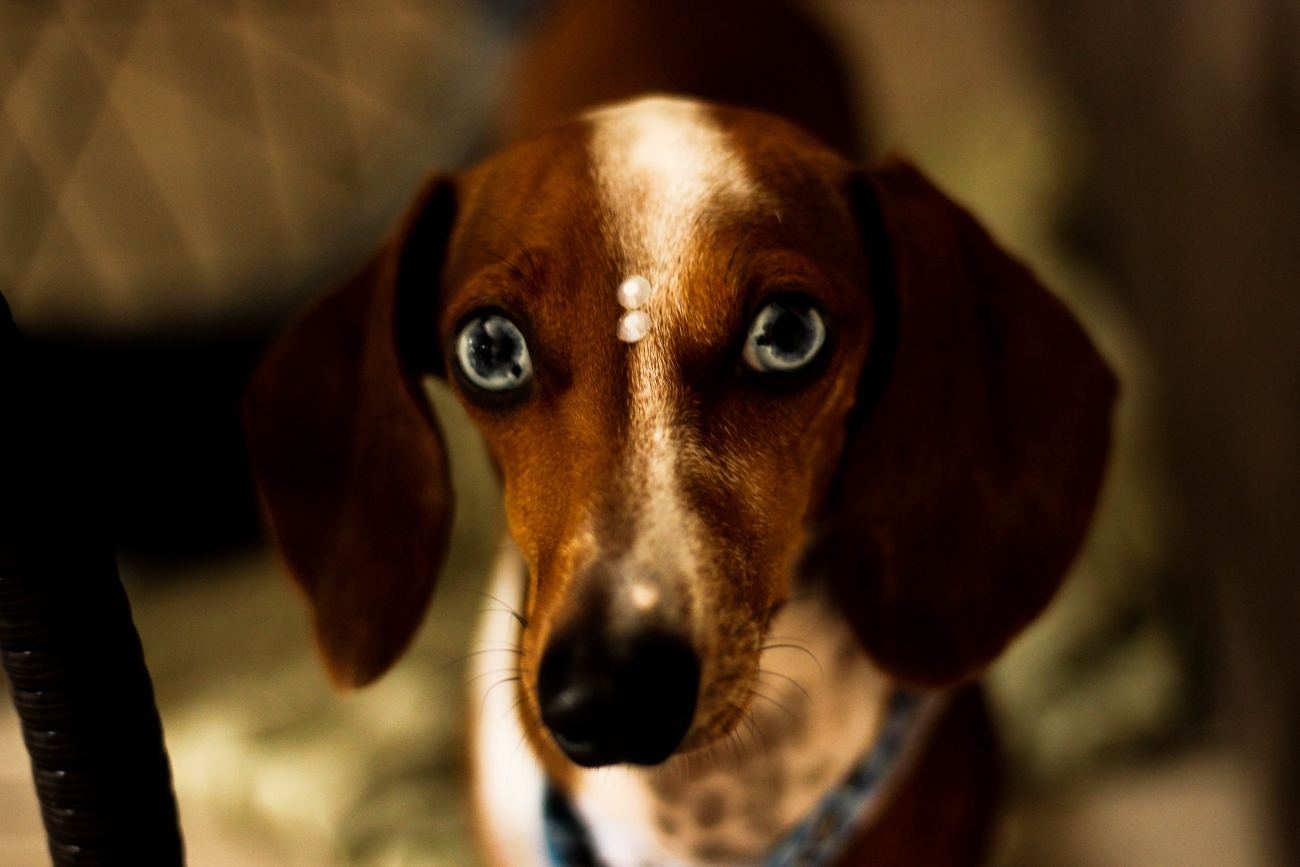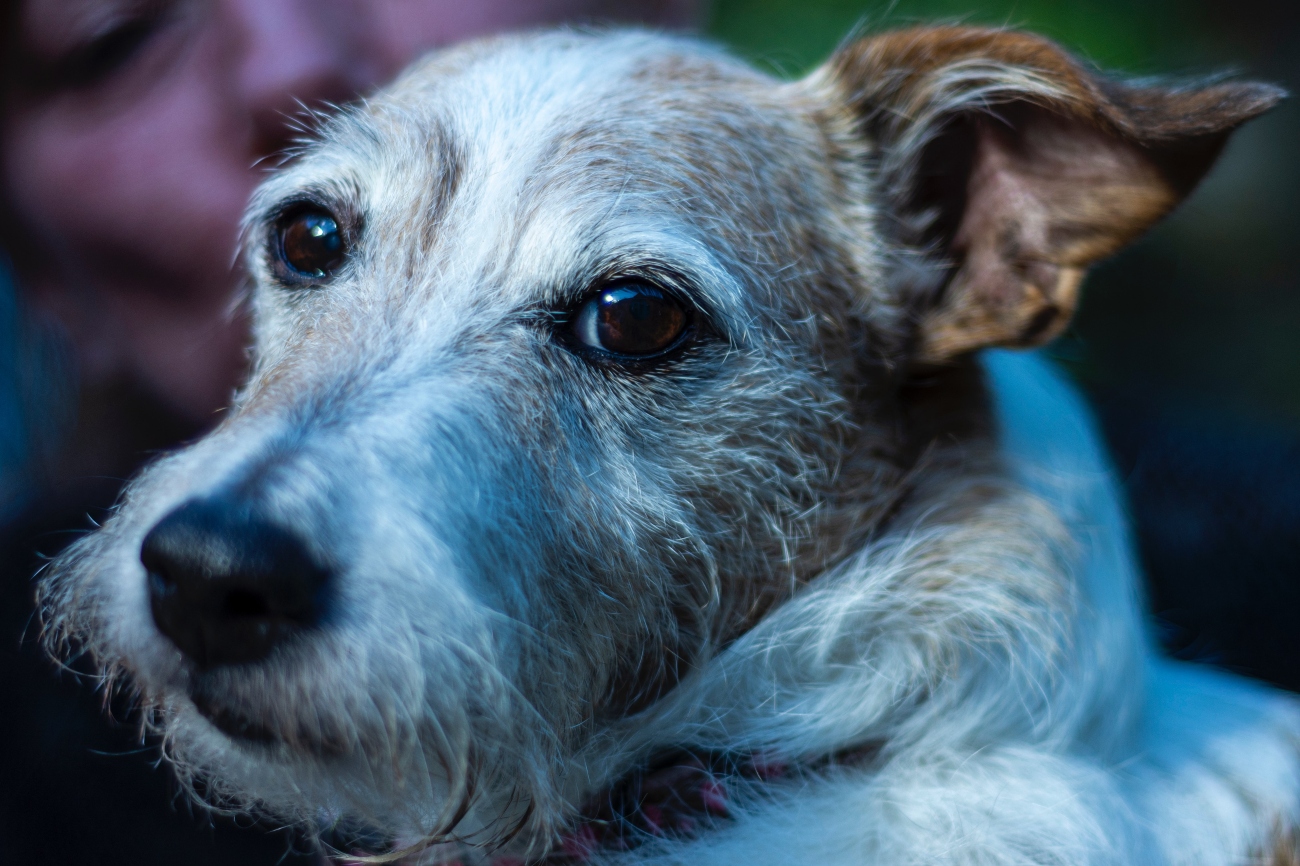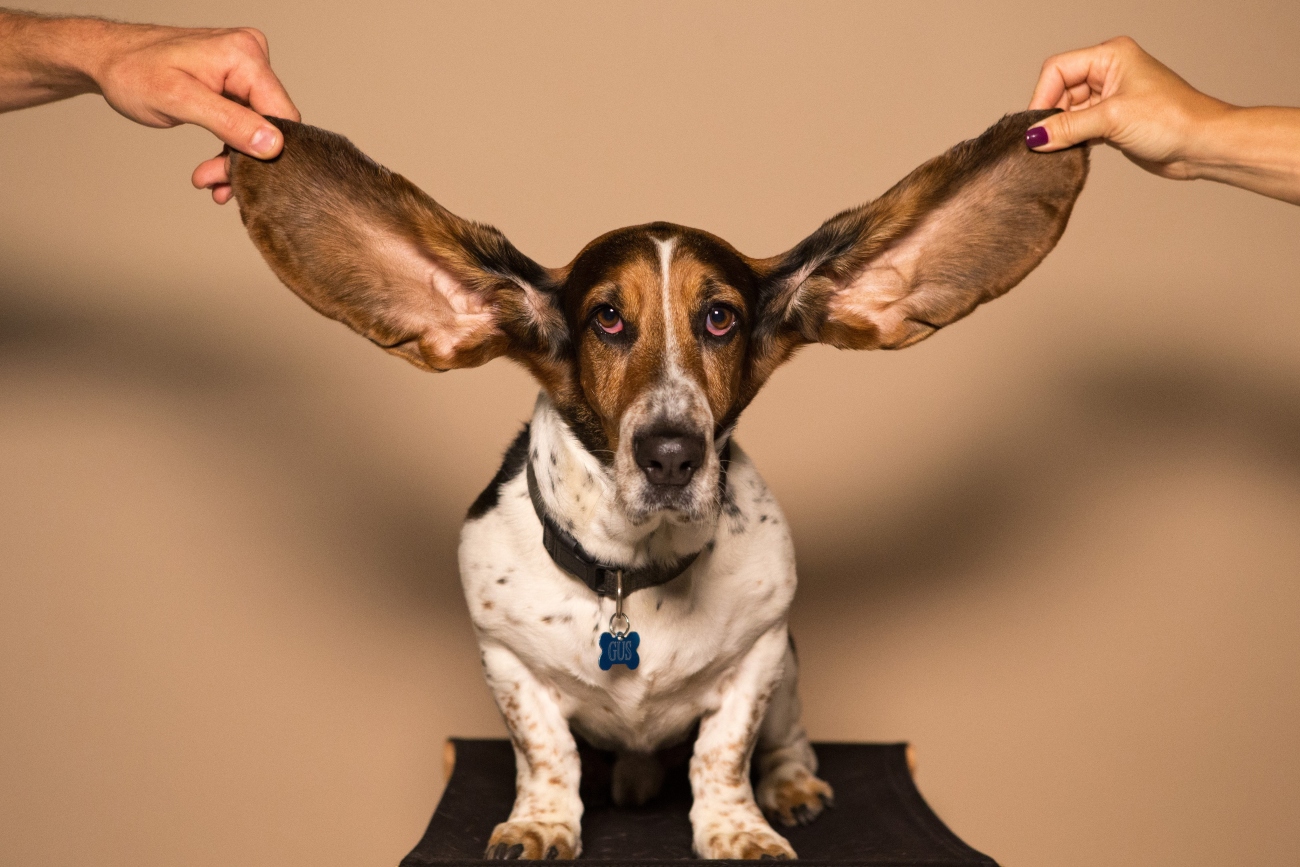
Common eye problems for older dogs
28th February, 2022
Have you noticed a change in your dog’s eyesight? Like their owners, dogs can fall prey to a number of different eye conditions. If left untreated, some of these can result in partial or complete loss of sight.
Older dogs are more at risk, as their eyesight begins to deteriorate from middle age onwards. If you suspect your dog may be affected by an eye problem, the advice remains the same whatever the concern: take it seriously and seek medical help.
Many medical procedures involving eyes are complex and expensive. For that reason, we would recommend arranging some pet insurance for older dogs as soon as your beloved friend enters old age.
Benefits of taking out pet insurance for older dogs with Petwise include access to our 24-hour Vet Helpline. As a Petwise customer, you can call this number whenever you have a question about your dog’s health. One of our dedicated team of veterinary nurses will listen to your concern and give their professional recommendation on what steps to take next.
And remember, there’s no upper age limit for joining Petwise. Whether your dog is seven or 17, we can help you find the right cover for them.
Let’s run through some of the common eye problems that may affect older dogs and the symptoms to look out for.

Dry eye
This painful condition starts when a dog is unable to produce their normal amount of tears. Tears lubricate the eye, and without them dogs' eyes can become very painful – so dry eye is a serious condition.
The illness tends to affect both eyes at the same time. You will notice your pet's eyes becoming dry and inflamed. If left untreated, dry eye can lead to conjunctivitis or eye ulcers, both of which we'll discuss below. There can be permanent scarring in severe cases, too.
While it can't be cured, the condition can usually be managed: you will need to give your dog eye drops and take extra care of them at home.
Dry eye is caused by a malfunction in the immune system, which leads to the body destroying its own tear glands and not producing tears in sufficient quantities. You'll see the effects gradually, over some months or even years. If you can get the condition diagnosed and treated early on, it’s usually possible to slow it down.
Symptoms
- Thick, sticky discharge around the eyes.
- Eyes that are red and inflamed.
- Eyes that are cloudy and dull without their usual shine.
- Blinking more than usual.
- Rubbing or pawing at their face more than usual.
Treatment
Depending on severity, the condition will be managed either with a combination of eye drops, 'false tears' (a commercially available solution, similar to eye drops) and regular eye wiping; or surgery, which will be expensive. We'd recommend having some pet insurance for older dogs in place – particularly if you own one of the at-risk breeds listed below.
Breeds most at risk
Cavalier King Charles Spaniel, Pug, West Highland and Yorkshire Terrier, and the Shih Tzu.
Eyelash problems
Dogs are quite prone to problems with their eyelashes. They may have lashes growing from where they shouldn't; their lashes may grow in the wrong direction; they may even have a whole extra line of lashes.
But why is this a problem? Well, if these lashes start to rub against the surface of the eye, this can result in irritation for your dog. This can become painful, and can even result in damage to the eye itself. If these eyelash abnormalities are not dealt with early on, they can bring in their wake more severe eye problems – such as corneal ulcers, scarring, and even loss of vision.
These stray or excess eyelashes can often be difficult for owners to see with the naked eye. You'll be more likely to spot other symptoms arising from them.
The good news is that problem eyelashes can usually be removed easily by a professional. If you believe your dog is being troubled by a rogue eyelash, get in touch with your vet as soon as possible.
Symptoms
- Weeping eyes.
- Painful or red areas.
- A redness in the eye itself.
Treatment
This will depend on where the problem eyelash is, and how much it is irritating the eye. However, the most common options include surgery to cut away the lash and its root, or cryotherapy – where the lash is removed by freezing.
If possible, the vet may simply remove each eyelash without surgery. This will improve the outlook for your dog until the problem eyelashes grow back, but it isn't usually a long-term solution.
Breeds most at risk
Bulldog, Cockapoo, Dachshund, Poodle, Shih Tzu, Cocker Spaniel, Bulldog and Pug.
Conjunctivitis
This condition features an inflammation, or swelling, of the conjunctiva, a thin layer of tissue that covers the inside of the eyelid and runs across the front of the eye. Conjunctivitis can have a number of causes, but the effects and symptoms are usually the same. You will notice that your dog is suffering from red, itchy, and/or weepy eyes: those eyes may even become swollen.
You'll find a full list of the various conditions that can come hand-in-hand with conjunctivitis on this page of the PDSA website.
Symptoms
- Blinking more than usual.
- Cloudy eyes.
- General listless appearance.
- Loss of appetite.
Treatment
Treatment will depend on the cause of the irritation. It can, for example, be caused by some external irritant – such as acid, sand, dust or smoke – coming into contact with your dog's eyes.
There may be a bacterial infection at work: indeed, many different bacteria can result in eye infections.
Or your dog may have an allergic reaction that affects the skin surrounding the eyes. Treatments can include eye drops, antihistamines or surgery, depending on the cause.
Breeds most at risk
Labrador, Springer Spaniel, Husky - but all breeds can suffer from conjunctivitis.
Remember to keep your dog's vaccination programme up to date. Like your pet insurance for older dogs, it's just one of those things you want to keep on top of year after year, to maximize your beloved dog's chances of a healthy old age.
Glaucoma
Brought about by increased pressure inside the eye, glaucoma is another painful condition – and, once again, it can lead to blindness if left untreated.
Glaucoma exists in two main types – primary, and secondary glaucoma. Unfortunately, it can't be cured. However, as with many other conditions, it can be well managed through the use of medication and eye drops, meaning that dogs with the disease can continue to lead normal, active and happy lives. That said, most dogs suffering from glaucoma will eventually lose their sight, even with treatment.
However, the earlier it is diagnosed and treated, the more years of decent vision your dog will enjoy. And indeed, as we discussed in our article on common signs that your dog's eyesight is deteriorating, they are very adaptable animals who will find a way to keep doing what they love, even with reduced eyesight!
Glaucoma occurs because of an excessive buildup of fluid in the eye. This fluid continually flows in and out of the eyes, bringing with it nutrients and making sure that eyes remain the correct shape and pressure. However, if something blocks the fluid from draining out of the eye, it will build up to uncomfortable and potentially dangerous pressures.
Dogs may get glaucoma in one or both eyes.
Symptoms
- Severe eye pain – this may manifest itself in your dog squinting, shying away from bright light, and/or rubbing their face.
- Weepy eyes, or the eyes may become cloudy and bluish.
- The pupils might dilate, and one may seem larger than the other.
- Bulging eyes.
Treatment
A severe case will require emergency treatment, which will probably involve a stay at a veterinary hospital while anti-glaucoma medication is administered, to reduce the pressure in their eyes.
Once again, this will prove expensive, so make sure you have some pet insurance for older dogs in place. After that, your dog will probably need to remain on anti-glaucoma medication (typically eye drops) for some time. Regular check-ups are also recommended.
Breeds most at risk
Cocker Spaniel, Springer Spaniel, Basset Hound, Labrador and Golden Retriever, Great Dane and Welsh Terrier.

Progressive Retinal Atrophy (PRA)
As its name suggests, this is a condition that develops progressively – over a period or months or even years.
An inherited disease, Progressive Retinal Atrophy (PRA) typically results in blindness over time. It is a progressive weakening and degeneration of the retina, the layer of tissue in the back of your eye that senses light and sends images to your brain. In short, the retina is crucial to good eyesight – so, unlike other eye conditions where the worst outcome may only be some pain and irritation, PRA is always a serious optical illness.
As the disease is hereditary, in some cases it's useful to perform a DNA test on some dogs (especially younger animals and those used for breeding), to see whether they are at risk of developing the condition. You can find out more about DNA profiling in dogs in our blog post on the subject.
Symptoms
- Night blindness or being nervous of going out at night.
- Bumping into furniture in the dark.
- Dilated pupils.
- More shiny or reflective than usual.
Treatment
As yet there is no effective treatment for PRA. Dogs affected with the condition are likely to become totally blind over time – however, the process can be a long one and your dog may have months or even years of serviceable vision. What's more, dogs are extremely adaptable and often learn to cope well with blindness, simply using their other senses more to help them navigate around.
Breeds most at risk
Toy Poodle, Cocker Spaniel, Labrador Retrievers, Miniature long-haired Dachshunds and Yorkshire Terriers. But all breeds can suffer from PRA.
Cherry eye
This condition is frequently very easy to diagnose. It occurs when a gland inside a dog's third eyelid pops out. The protruding gland resembles a small cherry in the corner of the eye – hence the name.
The condition itself is uncomfortable for dogs. What's more, it can lead to other problems, such as conjunctivitis and corneal ulcers. Most dogs with cherry eye will require surgery to restore the gland to its proper place.
But what's this about a third eyelid? Yes: in addition to their lower and upper eyelids, dogs have a third one that slides across the entire eye. It contains a tear gland and tears are essential for keeping the eyes lubricated. It is this tear gland that can, occasionally, prolapse (or pop out), creating the syndrome known as cherry eye.
Symptoms
- Dry eyes
- Excessive tear production
- Oval swelling on the edge of the third eyelid
- Squinting
Treatment
Cherry eye is treated by sewing the tear gland back into a small pocket within the third eyelid. This surgical procedure is usually successful: however, it can take more than one attempt to sort out the problem, as the gland can sometimes pop out again.
Your vet may also recommend eye drops for your dog, before and after surgery – to keep the eye moist, to bring down any swelling, and/or to administer antibiotics in the event of an infection developing.
Breeds most at risk
Bulldog, (both British and French), Beagle, Great Dane, Cocker Spaniel, Shih Tzu, Pug and Bull Mastiff. Cherry eye seems to be hereditary.
Owners of these breeds should get some specialist pet insurance for older dogs in place to help bear some of the costs of treatment, should it become necessary.
Eye ulcers
An eye ulcer is essentially a wound to the cornea, or surface of the eye. An ulcer like this will always require treatment to speed along the healing process.
These ulcers can often appear quite suddenly – and can deteriorate quickly. If that sounds alarming, the good news is that eyes are also able to heal quickly. As long as you get your dog to a vet before the ulcer develops too far, they should recover without any long-lasting complications. For that reason, we would recommend – as ever – contacting your vet as soon as you notice anything wrong with your pet's eye.
Symptoms
- Red, inflamed or bloodshot eyes.
- A small hole or crater on its surface.
- Excessive closing, blinking or squinting.
- Cloudy eyes.
- Reluctance to look at bright lights.
Treatment
These ulcers can vary in depth, from something very shallow such as a small scratch or graze, to something deeper and more serious. The problem here is that the front of the eye is very thin, and a deeper ulcer can cause it to burst. If that does occur, the eye is likely to need either attention from a specialist eye clinic – or removal altogether. This will be an expensive procedure, but if you have some pet insurance for older dogs in place, this should help to shoulder the costs.
Breed most at risk
Eye ulcers can affect all breeds.
Uveitis
Occurring in both dogs and cats, uveitis typically runs hand-in-hand with other underlying health conditions, whether in the eye or elsewhere in the animal's body. For this reason, in order to diagnose uveitis, a vet will need to make a detailed investigation of the affected eye – alongside a more general assessment of your dog's overall health.
But what is uveitis? Essentially, it's an inflammation of the middle section of the pet’s eye, whether as a result of an eye-specific problem or some issue elsewhere in the body. It can be caused by an accident – by a twig or branch getting into the eye, for example. Also, in dogs, uveitis can often follow on from other eye conditions such as cataracts, corneal ulcers and tumours of the eye.
Symptoms
- Increased blinking and squinting
- A watery discharge coming from the eye
- Heightened sensitivity to light
- Conjunctivitis
- Swelling of the white of the eye
- Cloudiness in the eye
If you do suspect uveitis, make sure you get your dog seen by a vet as soon as possible. It's essential to treat this illness quickly in order to ward off any long-term damage to the eye, or even – the worst-case scenario – blindness.
Treatment
As in many of these conditions, the precise course of treatment will depend on each individual case – in this instance, on the source and severity of the inflammation.
Steroids may be administered, either in the form of eye drops, injections or pills, in order to reduce the inflammation. Atropine, a prescription medicine, may be used to relax the iris and bring down any pain and scarring.
If a bacterial infection is believed to be the culprit, antibiotics will be prescribed.
Breeds most at risk
All breeds can suffer with this condition.

A final word about cataracts
Dogs can be susceptible to cataracts, a condition that causes the lens inside the eye to become cloudy. This cloudiness means that vision is impeded: in fact, if left untreated cataracts can, over time, lead to partial or complete blindness.
Cataracts can be caused by a variety of different factors. In fact, older dogs are more at risk than their younger counterparts. These 'senile cataracts' tend to develop fairly slowly, resulting in a gradual loss of vision so the signs can be hard to spot.
It's also worth being aware that a cloudiness within your dog's eye doesn't inevitably mean cataracts. Glaucoma, ulcers, and uveitis, all of which we discuss here, can also be causes. Nuclear sclerosis, a fairly common condition in older dogs, also produces a cloudiness in the eyes. This is, however, a natural product of the ageing process and – unless it becomes severe – won't affect your dog's vision.
Other conditions can themselves lead to cataracts. For example, dogs with diabetes are more susceptible to the condition. The reason for this is that the high levels of blood sugar present during diabetes can mean that some enters the lens of the eye, turning it cloudy.
In fact, diabetic cataracts can worsen quite quickly and can result in a total loss of vision – so if your senior dog does become diabetic, do monitor their eyes for any sign of cloudiness.
Diabetes itself is most likely to develop in more overweight dogs. If you worry that your dog may have gained weight during the recent UK lockdowns, do read our helpful advice feature on getting them back into shape.
Help your aging canine with pet insurance for older dogs
Here at Petwise, we want to help you to provide and care for your beloved pet in their later years. That's why our pet insurance for older dogs comes with a host of benefits including:
- No upper age joining limit
- Manage your documents online
- 15 levels of Lifetime Cover
- 24-hour Vet Helpline